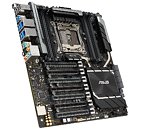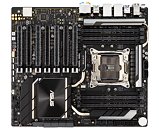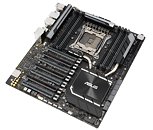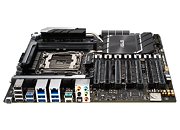Monday, December 9th 2019

ASUS Rolls Out Pro WS X299 SAGE II Motherboard
ASUS today rolled out the Pro WS X299 SAGE II, a redesign and refresh of its WS X299 SAGE series quasi-workstation motherboards, designed for those who want to use Intel's 10th generation Core XE "Cascade Lake-X" HEDT processors in a workstation-like environment (CEB form-factor) and can make do without ECC memory. The board draws power from a combination of 24-pin ATX and two 8-pin EPS power connectors, along with an optional 6-pin PCIe power input to stabilize add-on card power delivery. An 8-phase VRM conditions power for the socket LGA2066 processor. The board employs PLX PEX8747 bridge chips to convert two x16 PCIe gen 3.0 links from the LGA2066 processor to four PCI-Express 3.0 x16 slots with full bandwidth, or seven slots with x16/x8/x8/x8/x8/x8/x8 wiring.
Storage options on the ASUS Pro WS X299 SAGE II include three U.2 ports, two M.2 slots (one right below the PCH heatsink, and the other vertical); and eight SATA 6 Gbps ports. Network connectivity includes two 2.5 GbE interfaces driven by a pair of Intel i225-LM controllers. USB connectivity includes two USB 3.2 Gen 2 ports driven by an ASMedia controller (from which one is type-C), a second such controller driving an internal port, and eight USB 3.2 gen 1 ports from the X299 PCH. A high-grade onboard audio solution featuring Realtek S1220A HDA codec, headphones amp, ground-layer isolation, and audio-grade capacitors, make for the rest of this board. The company didn't reveal pricing.
Storage options on the ASUS Pro WS X299 SAGE II include three U.2 ports, two M.2 slots (one right below the PCH heatsink, and the other vertical); and eight SATA 6 Gbps ports. Network connectivity includes two 2.5 GbE interfaces driven by a pair of Intel i225-LM controllers. USB connectivity includes two USB 3.2 Gen 2 ports driven by an ASMedia controller (from which one is type-C), a second such controller driving an internal port, and eight USB 3.2 gen 1 ports from the X299 PCH. A high-grade onboard audio solution featuring Realtek S1220A HDA codec, headphones amp, ground-layer isolation, and audio-grade capacitors, make for the rest of this board. The company didn't reveal pricing.





22 Comments on ASUS Rolls Out Pro WS X299 SAGE II Motherboard
we heard you like pci-e slots...
Imagine how many coins per day it could mine with the right cards.
Of course this will not be a platform of choice for CPU-heavy loads, for OC, for gaming and so on. And it lacks ECC, so it's not for production systems as well.
But how many of these boards is Asus hoping to sell yearly? 10k?
There are 1 mln Kaggle users, with top few % using PCs that most high-end gamers haven't even seen live. And Asus just made a board for their next build.
You can put a bunch of big GPUs and fast SSDs on that and train neural networks or run engineering simulations 24/7 with just about any 10th gen CPU announced.
And it is a robust, stable platform. And software is optimized for these CPUs (lets not dive into discussing whether it's because of market demand or divine intervention).
And it's maintenance-free, so you don't have to be a geek to own one.
Sure, the value is pretty bad compared to other choices, but honestly: it's been true for all ASUS WS boards and they still sell pretty well. :)
Even if you peal off all RGB/OC/gaming things, ROG motherboards are still better equipped.
It's 2019. At over $400 TRX40-Pro doesn't provide WiFi nor BT.
PRIME X299-DELUXE II is noticeably better equipped.
But, compered to a 30-40$ Wifi-BT add-in card you can add to the TRX40-Pro (there's even the dedicated socket for it), you cannot add PCIE 4.0 compatibility to X299, you can't add the lanes that come with this platform, you can't add the option to host a CPU that's up to X4 as powerful as a 10980XE (3990X).
Gotta weigh the positives and negatives between the two.
This particular mobo launched at $499, so in the same segment. Not much changed.
... or I don't get your argument...Neither can I remove PCIe 4.0, which I'm forced to pay for with very little use cases at the moment.
More importantly: I don't know why you've moved to Intel vs AMD comparison.
Some X299 mobos have wireless, some don't. Same for sTRX4.
I've mentioned that board, because it's the same Asus series and roughly similar pricing.
For extra $50 you get WiFi 6, BT, WiGig, dual LAN (one 5Gb), dual Thunderbolt 3...
Sure, you can add many things with add-in cards, but what are you paying that $450 for?
Based on features alone TRX40-Pro is more like Prime X299-A II and that one is just $350.
I just don't understand why TRX40-Pro is so expensive...
And it's not like WiFi or BT are luxurious or niche features. They're included in majority of PCs sold today.
You can say the same about low end X570 boards at the time a high end X470 board were available at a similar price
X299 board may be "better equipped" for the price of a lower end SKU on a higher end platform such as TRX40, it makes complete sense. Costs went into other places in the design
The comparison is not Intel to AMD, its X299 to TRX40.
But I concede that Asus boards are quirky to say the least. (running one right now ugh)
--
In truth this board with refreshed 48-lane processors should have been released in 2017 not right now. Out of curiosity: I don't get it why WS boards are without built-in I/O shields covers - they look nice and prevent dust build-up, seems that 'workstation folks' are unworthy of such practical items. But, seriously even me just itching to dump 1st gen TR which is a biach.
One TRX40 board I'm interested in is Gigabyte Designare. The only one which can be really called workstation board. You get TB3 connectivity out of the box. Almost non-existent amount of RGB (tiny little strip which can be disabled anyway). One thing which annoys me with all TR boards (all generations) is that 4 slot 16/8/16/8 configuration; without actual physical 7 or 8 slots (XL-ATX in case of Gigabyte boards) with lane switchers. For the price already I would pay extra for freedom of choice. Take that Designare I've mentioned. When you plug Titan-Ridge controller into x8 slot you wasting x4 lanes which cannot be assigned anywhere else. And that's a bummer for me when counting every PCIe lane available.
I already have 3 true servers so didn't need more of them at the moment. What drew me to this one was large memory capacity, and especially the dual PLX chips for more lanes, and the lack of "bling". I am about to order some new water blocks to put my GPU's on water, then I'll likely get 2 more GPU's as well.
valid.x86.fr/y1srm1
Also I am buying for the long term, so thinking PCI v4 would serve me well in 5 years for upgrades. I would like to do x3 m.2 drives and couple of SATAs for big storage. Ill invest like 10k Euro for the long term so if there is a better board Ill buy it.
I am a 3d/2d motion designer pushing threads and mhz as far as possible, all day, everyday. CPU rendering and increasingly over to GPU rendering. Zero gaming (how unusual is that, I could make games in 3d but I've no interest!). Every site I go to reading about advice, just gives a 'depends' answer. Is the SAGE II the one to go for? Workstation and speed first, the RGB thing is of no interest to me either. Discreet.
Any thoughts would be appreciated.
Tks
Alan.
Many people look at these HEDT workstation boards as a cheaper server. While there is certainly merit to that thought, I tend to think of it, and describe them more as a crossover board between work and play. I have tried gaming on full-on servers before and chipset compatibility was always a problem. The HEDT's generally don't have this issue. Most servers and the processors for them can't be OC'd whereas this board can. However, there is a new Xeon flagship model that can OC (Xeon W-3175X). But, if you are spending your working day making money with your computer, how much will you want to push it overclocking it?
In the 2 years since my above post, I have pushed my speeds up to 4.6 for 24/7 after I bought a new power supply. It will run 4.8 24/7, but runs slightly above what I want it to temp-wise. I am in the process of moving off an all-in-one water cooler for CPU to custom built and that should allow me to keep the 4.8ghz. I spent around $8k USD 2 years ago. It has the i9-9980xe, 128 gb of DDR4 3866, 2TB M.2 NVMe plus 10TB 7.200 RPM drive for storage. I access anything larger from my NAS's or SAN's. I also outfitted it with 2 x EVGA 2080ti cards and still had a couple of aging Quadro that I put in as well. I powered it with a new Corsair AX1600i and put it in a Fractal Design R-6 Define but just ordered a R-7XL for more room for the water cooling components.
If you rely on this system for your main income source, I'd suggest getting a dual processor tower server full of x16 slots and big power supplies. Tower servers are generally better than rack for GPU's as they are a little more roomy making cabling easier internally. Some 4u+ rack servers will work too if you already have a rack. Also, if ordering a Dell, it is worth a call to make sure you won't need a "GPU enablement kit" that they only sell at the time of purchase, yet at the time I bought my T630 they failed to tell me. Note too that if you are stuffing all those GPU's into on box on air, it will make some noise. You may not want it in the room with you. My x299 Sage is in my server room with the rest of my equipment and I can't hear it over the AC in that 8 x 12' room. It is by far the most powerful system in there. Another option is also in the middle is the real "workstation" pre-built systems. My prior system to this one for this exact role was a Dell Precision. It is now over 8 years old but it had dual 6 core Xeons and 72gb of DDR3 ECC memory. Other than the power supply, it had numerous redundancies built in. lf you can't afford to be without your system for a few days should something fail, then once again I'd point you back to servers.
So, I'll somewhat join the "it depends" club. This board, and honestly the x299 processors they support, are getting to be old news. As much as it pains me to say it, AMD is kicking Intel all over right now in this price point and market segment. Ironically, I have used AMD probably 90% during the last 25 years due to the cost. But, both times I saved up and bought an Intel, they ended up falling behind.
For me, they are still exactly what the doctor ordered. I have mine fairly decked out and will only do video card refreshes after a couple more years. I hope to get 6+ years out of this system for its present use then I'll probably relinquish it to gaming only at that time.
Some good experienced outlook there. Yes you have reminded me how important it is to retain reliability in a system. I am now looking at Puget systems X5950 build with 3090s. Seems like a good option. (ill have to build myself as not in the USA). So I get really fast single thread. Reasonable cores, all fast. To pull back a bit for reliability and keeping system stable - Ill go for x2 GPU not 4. And going to stick with air cooling for reducing points of failure. That seems like a good compromise to me. Then I may keep old z800 on site for system failure and perhaps offloading render. The z800 actually isn't bad for a 2011 pc. I got m.2 drive booting OS and another pci-m.2 for projects.